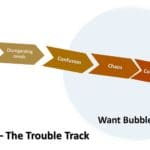Beach Bungle follows 2 young seagulls – Olive and Jay – through their day on a beach. Jay is accompanying big sister Olive for the first time to play on the beach. He is obviously excited about the new experience – new things he sees, new games he plays. He gets so engrossed in ‘exploring’ that he doesn’t even realise that he is hungry.
Sounds familiar?
‘Yummy worms in red shell’ (French fries) prove to be a trigger that sets Jay on the ‘Trouble Track into Want Bubble’. Olive finds Jay under a big mountain of stuff he has collected, still hungry.
Jay’s busy, exciting and tiring day and the distraction leading to a big commotion on the beach, demonstrates the various stages of ‘wants taking over needs’.
Jay gets distracted by the novelty of ‘yummy worms’ in the ‘red shell’ (pack of fries). His attraction to the ‘novelty aspect’ of fries overtakes his need for food. Disregarding this need for food, he goes after all things new to him on the beach.
In the state of confusion on what he set out for in the first place (food or novelty), Jay starts collecting stuff, even snatching them from people, in a disorderly manner. What transpires is a commotion of ‘I want’, ‘I want more’, ‘I want it now’, even after Jay acquires, in Olive’s words, ‘everything there was on the beach’.

When Olive confronts her little brother about this odd behaviour and helps him meet his need, Jay feels embarrassed of his behaviour and the stuff he collected which now is nothing more than trash – his beach bungle.
Happiness and calm is restored once Jay gets what he needs. Jay is happy and he wants no more.
But, at bedtime, it is Olive’s turn to want more – stories, and Jay gets to give back the new lesson he learnt to make Olive realise her need – sound sleep. The story ends with a chuckle.
The story is written in small chapters with simple, short sentences, for beginner readers (6-7 years). With the book’s beautiful illustrations, younger children/ non-readers (3-5 years) can enjoy it being read to, as a picture book. Confident readers (8-9 years) will enjoy uncovering the concept behind this simple story.

